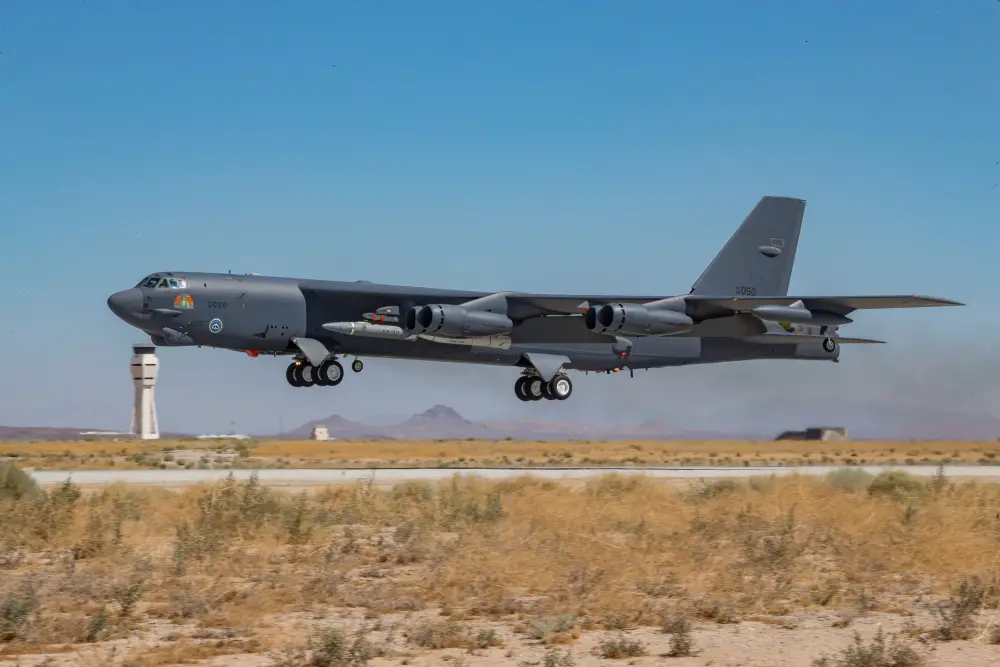The U.S. Air Force and Lockheed Martin successfully flight tested the second AGM-183A Air-Launched Rapid Response Weapon (ARRW) on the service’s B-52 Stratofortress out of Edwards Air Force Base, California, on Aug. 8, 2020. This is the first time a tactical ARRW missile has been assembled. This captive carry flight was conducted with tactical hardware and fully instrumented to collect thermal, mechanical and digital data from the flight vehicle. Additional ground and flight testing will follow over the next two years. The flight resulted in the successful transmission of telemetry and GPS data from the AGM-183A IMV-2 (Instrumented Measurement Vehicle) to Point Mugu Sea Range ground stations.
“The team overcame significant challenges driven by the COVID-19 pandemic to achieve this significant milestone for the program,” said Dave Berganini, ARRW program director at Lockheed Martin Missiles and Fire Control. “This captive carry mission is the pre-cursor for our first booster test flight planned for early 2020s.”
“The event this week demonstrated the ability to communicate with the prototype weapon; the entire team is excited to take the next step and begin energetic flight test of our first air-launched hypersonic weapons,” said Lt. Col. Michael Jungquist, 419th Flight Test Squadron Commander and Global Power Bomber Combined Test Force Director.

The test verified system integration with the B-52 launch platform and telemetry while practicing concepts of operations that will be utilized during its first Booster Test Flight later this year. The ARRW program is a rapid prototyping project aimed at delivering a conventional hypersonic weapons capability to the Warfighter in the early 2020s. The weapon system is designed to provide combatant commanders the capability to destroy high-value, time-sensitive targets. ARRW will also expand precision-strike weapon systems’ capabilities by enabling rapid response strikes against heavily defended land targets.
The 419th FLTS and Global Power Bomber CTF conduct flight test missions utilizing the Air Force’s inventory of bomber aircraft. The ARRW program development began with the Defense Advanced Research Projects Agency’s Tactical Boost Glide demonstration system, which will be integrated into the ARRW payload. It has successfully completed two prior captive-carry tests. This test of the AGM-183A IMV-2 was the culmination of efforts from across the Air Force Test Center enterprise, the Naval Air Warfare Center Weapons Division at Point Mugu, the ARRW Program Office and Lockheed Martin.

Hypersonic weapons provide rapid response, time critical capability that will overcome distance in contested environments using high speed, altitude and maneuverability. Lockheed Martin has played a significant role in the research, development and demonstration of hypersonic technologies for more than 30 years. The corporation has made significant investments in key technology and capability development. We have developed deep expertise in the engineering of hypersonic systems and associated challenges through our work with maneuvering reentry vehicles, air-breathing engine design, avionics, and aero/thermal flight sciences.
The AGM-183 ARRW is a prototype hypersonic weapon developed by Lockheed Martin, the missile has a reported maximum speed of Mach 20. It has been theorized to be the “Super-Duper Missile” referred to by President of the United States Donald Trump during a May 2020 press availability. The AGM-183A has a maximum speed of 15,345 miles per hour (24,695 km/h). The weapon uses a boost-glide system, in which it is propelled to hypersonic speed by a rocket on which it is mounted before gliding towards a target. The U.S. Air Force was considering using the remaining fleet of B-1B bombers as AGM-183A firing platforms, with each aircraft carrying up to 31 of the weapons mounted internally and on external pylons.
















